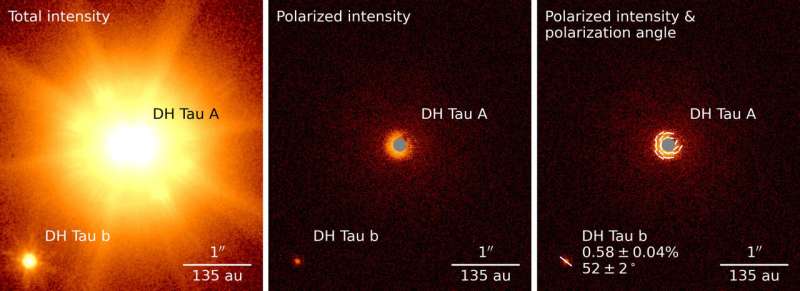
An international team led by Dutch astronomers has, after years of searching and defying the boundaries of a telescope, for the first time directly captured polarized light from an exoplanet. They can deduct from the light that a disk of dust and gas is orbiting around the exoplanet in which moons are possibly forming. The researchers will soon publish their findings in the journal Astronomy & Astrophysics.
The discovery concerns the exoplanet DH Tau b. This is a very young planet of only 2 million years old at 437 light years from Earth in the constellation Taurus. Exoplanet DH Tau b does not resemble our Earth. The planet is at least eleven times more massive than Jupiter, the most massive planet in our solar system. The planet is also located ten times further away from its star than our furthest planet Neptune. The planet is still glowing after its formation. As a result, it emits heat in the form of infrared radiation.
The researchers discovered that the infrared radiation of the planet is polarized. This means that the light waves vibrate in a preferential direction. And that, according to the researchers, is because the infrared radiation of the planet is scattered by a disk of dust and gas that orbits the planet. In such a disk, moons may form.
Furthermore, the disk around the planet appears to have a different orientation from the disk around the star. Such a tilted disk indicates that the planet has likely formed at a large distance from the star. This is contrary to the theory that planets are formed close to their star and then migrate outward.
For the observations, the astronomers used the SPHERE instrument on the Very Large Telescope of the European Southern Observatory (ESO) in Chile. This instrument can, among other things, block the overwhelming light of the associated star and determine the polarization of the remaining light.
First author and research leader Rob van Holstein (Leiden University, the Netherlands) has been working with the SPHERE instrument since his university study in 2014: "Because we fully understood the instrument, we were able to make it perform better than it was designed for. In the end, we were able to capture the light from twenty exoplanets, one of which had polarized light."
Co-author Frans Snik (Leiden University) has been trying to capture polarized light from planets since 2012: "It's already very special that we can see a planet separated from the star around which it orbits. And now we can also deduce that material is orbiting this planet as well, and that this material does so at a completely different angle than the disk that orbits the star. This gives us unique insights into how such a planet and possible moons are formed."
In the future, the researchers aim to carry out similar research on the Extremely Large Telescope that is under construction. This telescope should make it possible to study the light of rocky, Earth-like planets. From the polarization of the light it will be possible to obtain more information about the atmosphere of such planets and whether there are possible signs of life.
Explore further
Preprint: arxiv.org/abs/2101.04033
Citation: Astronomers finally measure polarized light from exoplanet (2021, January 12) retrieved 12 January 2021 from https://ift.tt/3nCkQV0
This document is subject to copyright. Apart from any fair dealing for the purpose of private study or research, no part may be reproduced without the written permission. The content is provided for information purposes only.
"light" - Google News
January 12, 2021 at 07:20PM
https://ift.tt/3nCkQV0
Astronomers finally measure polarized light from exoplanet - Phys.org
"light" - Google News
https://ift.tt/2Wm8QLw
https://ift.tt/2Stbv5k
Bagikan Berita Ini















0 Response to "Astronomers finally measure polarized light from exoplanet - Phys.org"
Post a Comment